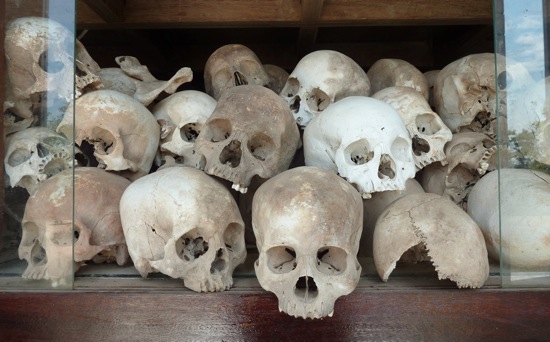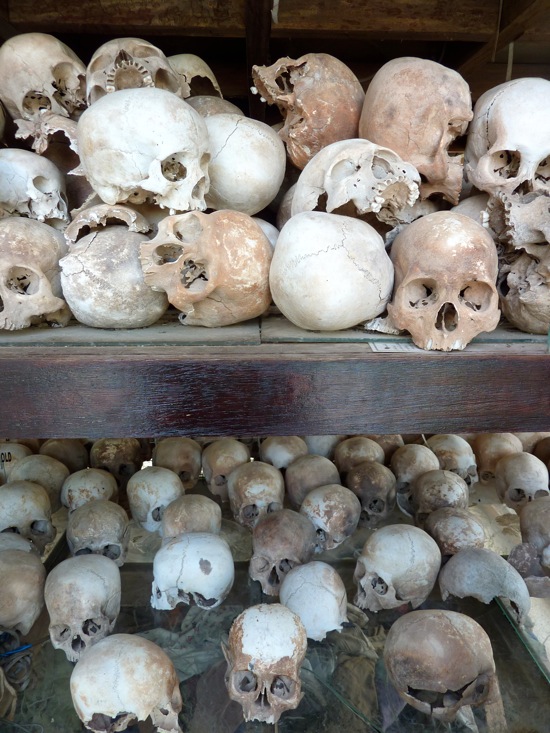- 31 . 03 . 11
Fair warning: This post describes crimes against humanity that are not for the faint-hearted.
- StumbleUpon
- TwitterTweet
- Facebook
-
Flickr
The Killing Fields
I can’t ever recall ever being as profoundly shocked as I was at the Killing Fields outside Phnom Penh.
The 30m tall memorial building is visible from quite a distance, but it is only up close that you recognise the horror. As the front door opens, you are confronted at eye-level with the skulls of dozens of 14-20 year old females, executed as part of the Communist purges. 16 further tiers rise above, housing the skulls and bones of around 9000 Khmer Rouge victims.
32 years after the closure of the camp, an estimated 11000 victims still remain buried. Natural erosion of the soil has exposed fractured bones and teeth shallow-buried in the dirt. Each year, after the rainy season, further bones rise to the surface in a grim harvest that serves as a perennial reminder of the atrocities.
Enemies of the regime were typically brought here from Tuol Sleng Prison after forced confessions had been extracted. They were driven to a holding facility, blindfolded, bound and led outside. After being instructed to kneel, they were summarily executed and thrown into a pit.
The murders were carried out with simple farm implements. Hoes, axes and cart axles were used to pierce, puncture or crush skulls. Simple, brutal and effective. When a grave was at capacity, it was immediately filled with dirt and a fresh one dug. The small number of victims who did not die immediately from the blows to the head were simply buried alive. DDT and other chemicals were spread over the bodies before burial, both to keep down the stench of death and to make certain nobody survived.
Party policy was that the children and babies of intellectuals offered no value, but could later seek revenge, so they too were slaughtered. When we pull up the rice plant, we pull too its roots. In a manner almost too savage to comprehend, babies were picked up by their ankles and were swung head-first into a tree, so as to cave in their skulls. An alternative was to throw them skywards by their ears and catch them on upturned bayonets or sharpened bamboo poles.
Those soldiers who refused to carry out their gruesome orders were beheaded slowly, using a serrated palm frond to saw through the neck and maximise the amount of suffering. Other soldiers were naturally made to watch the consequences of disobedience.
That bullets were considered too expensive to waste on killing those considered impure should indicate the callousness of the executioners and their total disregard for human life. Their frequently evoked motto: To keep you is no benefit. To destroy you is no loss.
There can be no doubt that in 4 short, brutal years, the Khmer Rouge entirely destroyed their own country.
Aside from the clear violence, it is difficult to even see the benefits in what they were trying to achieve. Their view of paradise was apparently a country filled only with rice fields and compliant, cowed workers, where there was no achievement, no exceptional behaviour, no artistic endeavours and no aspiration. For a ruling council with a university education, it is hard to fathom why they considered this a noble goal.
Complete national independence is perhaps an understandable, if somewhat naive aim. The manner in which it was attempted however, with total and immediate economic revolution was criminally incompetent. The cruelty with which this unnatural state was enforced, malicious and wicked.
Banks, hospitals, museums, police stations, schools and universities were destroyed. Traditional Khmer culture was repressed. Historical monuments and temples were destroyed. Religion was banned. Anything that spoke of a unique national character was removed. All private enterprise was banned and city dwellers sent to the countryside to farm rice where, critically underprepared and ill-suited to the task, they died of starvation and exposure. The intolerance of external influence extended to medicine, with the sick instead treated with traditional remedies. No doctors were around to administer treatment. Hundreds of thousands died from preventable disease.
In killing between 15% and 25% of its own people, and deliberately targeting educated professionals, lawyers and doctors, businessmen and bankers, they crippled the country’s ability to recover. By depriving Cambodia of its next generation of leaders and thinkers, it set the country back decades and left a tragic legacy that is apparent even today.
Today Cambodia is a Democratic Monarchy, with 11 active political parties. Elections are held every 5 years. People are, broadly speaking, content with their lives. There is poverty of course, but there is peace, and people are happy.
Many do not remember first hand the reign of terror which ended in 1979. It is imperative that we who follow do not forget.





Gaaaaaaaaaah!!!